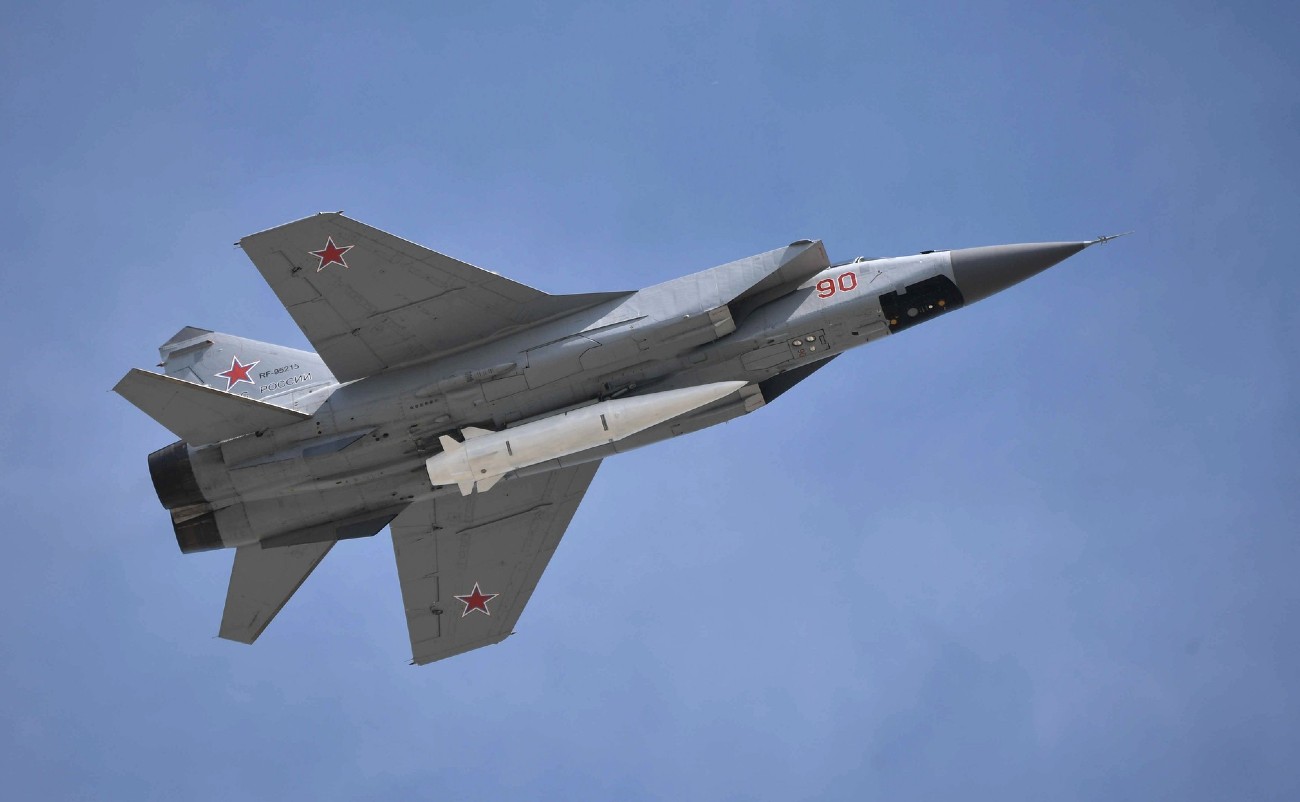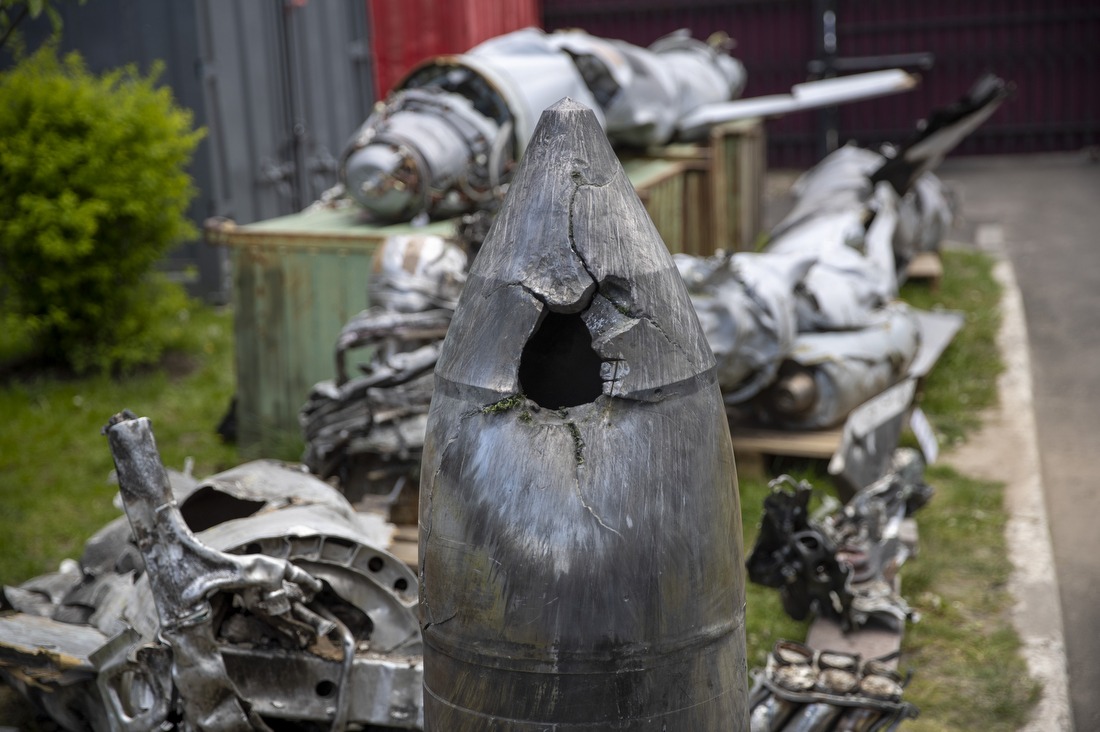In a continuing aerial strike on Ukraine this month, Russia employed its AS-24 KILLJOY hypersonic missile, which the country has projected as an “invincible weapon.” The rocket, however, was taken down by the Ukrainian air defense system, leaving Moscow with a red face again.
A EurAsian Times report last week quoted the spokesperson of the Ukrainian Air Force, Yuriy Inhat, announcing the shooting down of an X-47M Kinzhal (Killjoy) ballistic missile over Kyiv on December 14. The spokesperson then said, “One missile was shot down. This was later confirmed by Commander of the Air Forces Gen. Mykola Oleshchuk.
The Ukrainian Air Force reported that within ten minutes of taking flight from Savasleyka airport, Russian MiG-31K fighter jets armed with Kinzhal hypersonic missiles tried attacking targets in central Ukraine. The Ukrainian Air Force said one missile was shot down by the Air Force above the Kyiv region, while two more struck the Starokostiantyniv district.
These developments have now been confirmed by the UK Ministry of Defense (MoD) in its latest intelligence update. The UK MoD noted on December 19 that Russia’s air-launched ballistic missiles are not “undefeatable” in real-world situations. The update stated that the Russian hypersonic missiles made their “mixed combat debut” in Ukraine.
“On 14 December 2023, the Russian Air Force likely carried out the first use of an AS-24 KILLJOY air-launched ballistic missile since August 2023. Russia launched at least one missile into central Ukraine, likely targeting a military airfield,” it stated.
(3 of 3)
KILLJOY has almost certainly had a mixed combat debut. Many of its launches have likely missed their intended targets, while Ukraine has also succeeded in intercepting attacks by this supposedly ‘undefeatable’ system.
— Ministry of Defence 🇬🇧 (@DefenceHQ) December 19, 2023
The assessment observed that the KILLJOY is expected to be a key component of Russia’s military strategy and has been saved for targets that Moscow considers valuable and well-defended in Ukraine. The missile is one of the six superweapons unveiled by President Putin in 2018 and has since been known to be invincible.
At the time of unveiling this weapon, Russian President Putin had said that its speed “allows it to overcome all existing and, I think, prospective anti-aircraft and anti-missile defense systems, delivering nuclear and conventional warheads in a range of over 2,000 kilometers.”
The Kinzhal or Killjoy missile is a Russian hypersonic missile that could reach speeds greater than Mach 10 and travel 1,500 to 2,000 kilometers while carrying a conventional or nuclear payload. It is fired using the MiG-31K aircraft of the Russian Air Force, although the Su-34 has also reportedly test-fired a Kinzhal on Ukraine earlier this year.
The “invincible” Russian hypersonic missile has been shot down by Ukraine before. Using the venerable Patriot missile defense systems, Ukrainian soldiers claimed in May of this year that they shot down six Kinzhal hypersonic missiles in a single night.
Sounding a very skeptical note about the efficacy of the Russian hypersonic missiles, the UK MoD observed that “KILLJOY has almost certainly had a mixed combat debut. Many of its launches have likely missed their intended targets, while Ukraine has also succeeded in intercepting attacks by this supposedly ‘undefeatable’ system.”
These claims have also brought under scrutiny the efficacy of hypersonic weapons, which are being sought by military powers over the world. While China and Russia have fielded their hypersonic weapons, the United States has yet to operationalize one. Washington has had a spate of failures in testing the air-launched version of a hypersonic weapon.
Not only that, but several countries, including Australia, India, France, Germany, South Korea, and Japan, are also exploring the possibility of developing their own hypersonic weapons. Moreover, even countries like Iran and North Korea, which remain under crippling international sanctions, also allegedly possess hypersonic weapons.
However, the tall claims made by the Russian President about its hypersonic weapons and the fallibility of this missile seen in recent times have raised broader and more significant questions. The most important of these is whether the hypersonic weapons are mere hype or is just the Kinzhal failing to live up to the reputation of being an actual invincible hypersonic weapon that is almost impossible to intercept.
Decoding The Hype About Hypersonic Missiles
A missile is deemed “hypersonic” if it can move faster than five times the speed of sound while maintaining “significant maneuverability.”
In a nutshell, anything faster than Mach 5, or five times the speed of sound, about equal to a mile per second or a little over 100 kilometers per minute (60 miles per minute), is hypersonic. It is also incredibly tough to shoot down due to its highly agile speed and unpredictable trajectory with which an interceptor cannot keep up.
While hypersonic glide weapons and intercontinental ballistic missiles (ICBMs) are both launched high into the atmosphere by rockets, the former uses gravity to power its warhead once it starts to descend to its target. At the same time, the latter dives back to Earth before flattening out its flight path and using internal navigation devices to keep it on course while reaching speeds of up to 12 times the speed of sound.
An ICBM orbits the Earth at a lower altitude and is more maneuverable than a hypersonic one; the former has a parabolic trajectory, meaning it rises and falls in a high arc. They are more challenging to follow and counter because of their capacity to alter course, aim, and speed mid-trajectory.
The hypersonic missile’s plasma cloud is its most valuable feature. The missile is completely enveloped in a plasma cloud during flight, which absorbs all radiofrequency radiation and renders the weapon undetectable to radars.
This makes it possible for the missile to reach its target without being seen. As a result, a hypersonic missile can overcome an opponent’s sophisticated missile defense system. So, he may not be wrong when the Russian President says that a hypersonic weapon he is unveiling is undetectable.
Like ICBMs, hypersonic missiles can carry both conventional and nuclear warheads. However, unlike Russia, China, and North Korea, the US says its missiles that have been or are being tested can carry only conventional warheads. Despite the many struggles, the US is relentlessly working to develop and field its hypersonic weapons.
Some experts believe that Russia sounded a false alarm by exaggerating the invincibility of the weapon and its lead over the US in the use of hypersonic weapons.
Speaking to EurAsian Times, Group Captain Arvind Pandey(Retd), a geospatial intelligence professional and military analyst, said, “In this case, it is possible that the Kinzhal was not operating at hypersonic speed to begin with and, thus, was intercepted by the Patriot. Otherwise, the interception of hypersonic weapons is a very difficult task due to their inherent approach path toward the target. Detecting these weapons currently is questionable, and globally, there are efforts to develop space-based systems to enable this.”

Hypersonic weaponry falls into two main groups. One is a hypersonic glide vehicle (HGV), propelled to a destination by a rocket and gliding there. The other is hypersonic cruise missiles, or “scramjets,” air-breathing missiles that reach their target quickly. However, some pro-Western analysts have pointed out that Russian Kinzhal falls under neither category as it is an air-launched ballistic missile capable of achieving hypersonic speeds.
It has been noted that ballistic missiles such as the Kinzhal cannot sustain hypersonic flight, although they have the potential to do so with some degree of mobility.
Since several quarters have pointed out that the hypersonic weapons are more hyper than game-changers, Philippines-based military analyst Miguel Miranda said, “The hypersonic hype is a very tangible thing. What we’ve learned so far in the past several years is each country has a different conceptualization of what a “hypersonic” weapon system is. So what constitutes a “hypersonic” weapon is in flux. As for air-launched ballistic missiles that achieve hypersonic terminal speeds, these weapon systems will continue to proliferate because they are easy to produce; Israel, Turkiye, India, and Iran can accomplish the same if they want.
The Ukrainians are certainly reaping a lot of goodwill for their success versus Kinzhals launched at Kyiv. But this is just a single example in a particular conflict. We are in an era of low-cost “strategic” weapons whose characteristics can be rapidly altered and modified. There’s no way back now.”
There is another perspective in Washington D.C., though. According to a report published by the US Congressional Budget Office (CBO), since they travel through the atmosphere and below the height at which midcourse ballistic missile defenses normally function, hypersonic missiles can destroy long-range (midcourse) defenses. In addition to being more difficult to track and intercept, hypersonic missiles can move erratically at high speeds to circumvent close-quarters defenses.
Alternatively, it notes, ballistic missiles are also challenging to stop, especially if they have agile warheads to get past short-range missile defenses and countermeasures to fool midcourse missile defenses. Ballistic missiles are unlikely to be threatened mid-course by anything other than potent long-range defenses, which none of the possible U.S. enemies have yet to install.

However, the report emphasizes in no ambiguous terms that “Hypersonic missiles would probably not be more survivable than ballistic missiles with maneuverable warheads in a conflict unless the ballistic missiles encountered highly effective long-range defenses.”
Ballistic and hypersonic missiles are equally adapted to operate outside of anti-access and area-denial (A2/AD), or “keep-out,” zones established by possible enemies. The Department of Defense has devised a plan to eliminate the A2/AD zones being constructed by potential rivals, like China and Russia, early in a fight by using precise, long-range, high-speed missiles.
In the military scenarios CBO examined, the combination of speed, precision, range, and survivability—the capacity to reach a target without being intercepted—could be advantageous from hypersonic and ballistic missiles fitted with maneuverable warheads. However, such quick strikes are not necessary for many missions. Subsonic cruise missiles are less expensive than hypersonic and ballistic missiles for such missions.
The Pentagon is currently developing hypersonic weapons under the US Navy’s Conventional Prompt Strike program, which is intended to provide the US military with the ability to strike hardened or time-sensitive targets with conventional warheads, as well as through several Air Force, Army, and DARPA (Defense Advanced Research Projects Agency) programs.
A military commentator who did not want to be named said, “If the hypersonic weapons were not worth it, the US would not be so eager to field them. They are worth the hype, but no weapons ever are invincible because technology is evolving. You develop a weapon, and your adversary will develop a system to counter that weapon, much like the US is doing now with its GPI program. The question should be whether the Russian Killjoy missile is worth the hype.”
Besides developing its hypersonic weapons, the United States is also working to field the Glide Phase Interceptor (GPI) as a countermeasure to hypersonic weapons now in use with China and Russia. The US Congress is pressing the Missile Defense Agency to deploy interceptors capable of defeating hypersonic missiles sooner than the anticipated schedule.
The debate whether hypersonic missiles are the real deal or mere hype is an ongoing one, but all advanced militaries are currently seeking them for the promising capabilities that they have to offer. However, Russia’s Kinzhal hypersonic weapons putting up a no-show has added more complexities to the debate.
- Contact the author at sakshi.tiwari9555 (at) gmail.com
- Follow EurAsian Times on Google News




